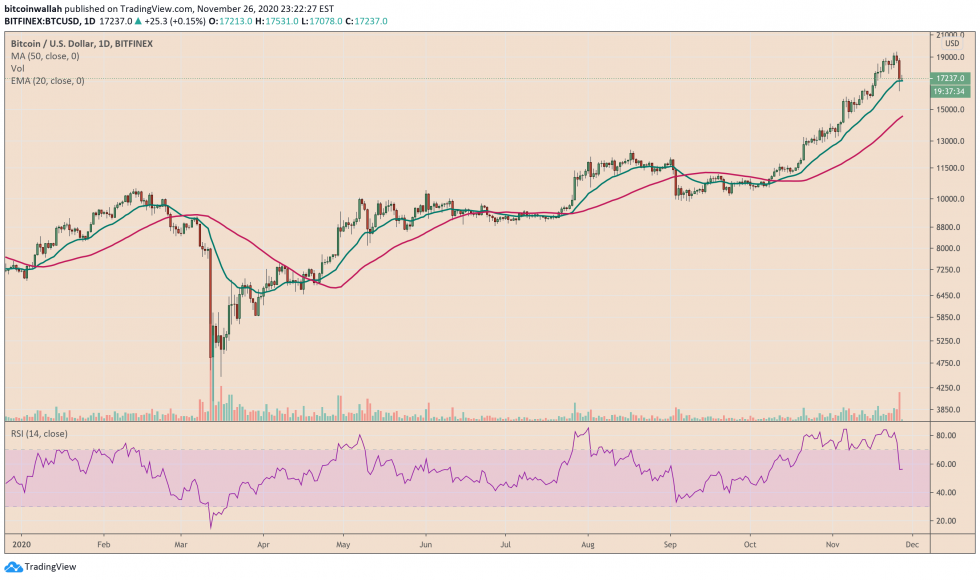The Bitcoin market suffered major losses mid-week as its price fell from its $19,500-top to as low as $16,200.
Some analysts believe the cryptocurrency has more room for declines, given its 100 percent upside rally before the latest correction. Nevertheless, macro fundamentals are still favoring the young asset’s bullish outlook.
One of Bitcoin’s major upside drivers is a weakening US dollar. The cryptocurrency was among the biggest beneficiaries after the Federal Reserve flooded global markets with excessive greenback liquidity through a flurry of emergency facilities to curb the coronavirus pandemic’s economic impact.

Bitcoin holds strong above technical support offered by its 20-day exponential moving average. Source: BTCUSD on TradingView.com
Many strategists expected the dollar to rebound after the US government reopened economies. While there were attempts, the US dollar index still declined, having hit its lowest level since 2018 just this week. Its downside bias showed investors’ likelihood to keep their exposure in riskier assets, thus giving Bitcoin ample opportunities to resume its uptrend.
“Excess dollar liquidity [from the Fed] is still in the system,” Salman Ahmed, global head of macro at Fidelity International, told WSJ. “Once things improve and reflation returns, that liquidity can go back into riskier assets.”
A 20% Decline Ahead for Dollar
Investors remain heavily invested in the US, which, in turn, keeps the demand for the greenback higher. But the arrival of a potential COVID-19 vaccine, coupled with expectations of a friendlier trade policy from the Joe Biden administration, makes foreign assets look more attractive.
But it does not mean whole-hearted capital inflow into the developed and emerging economies that are already suffering the aftermath of the pandemic. Interest rates remain stuck at lower levels in most countries, leaving them exposed to their riskier markets.
Therefore, for many strategists, the US dollar remains an overvalued asset, trading high than its actual rates due to a lack of global investment alternatives. A Citigroup report even suggests a 20 percent decline in the greenback’s value, driven lower as global investors hedge away from the US markets.
Hedge Where?
Bitcoin, even when it means receiving a comparatively little capital inflow than what the rest of the traditional market attracts.
The cryptocurrency recently hit all-time highs against several foreign currencies. It rose especially in the inflaton-hit regions like Turkey and Venezuela while emerging stronger in other struggling economies like Brazil, Argentina, Zambia, Sudan, Angola, and others.
Countries where #Bitcoin has hit a new ATH in their local currency:
Brazil – pop. 209million
Turkey – pop. 82m
Argentina – pop. 44.5m
Sudan – pop. 41m
Angola – pop. 30m
Venezuala – pop. 29m
Zambia – pop. 17mSoon:
Russia
Colombia… then all other fiat currencies
— Alistair Milne (@alistairmilne) October 22, 2020
Bitcoin was also trading near its record peak in the Russian, Columbian, and Eurozone markets.
The metrics showed a booming demand for the cryptocurrency assets in the said economies. Investors and traders both hedged into Bitcoin and its sister currencies to escape inflation uncertainty. In short, their deviation away from the US-pegged assets also raised BTC/USD’s potential to hit $20,000 despite cyclical downside corrections.
 bitcoinist.com
bitcoinist.com